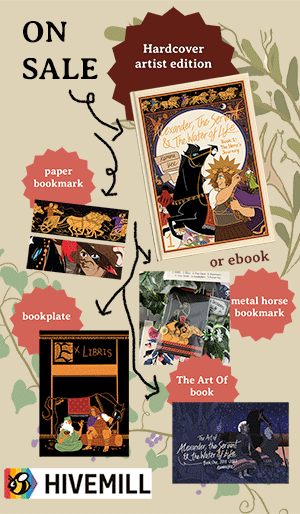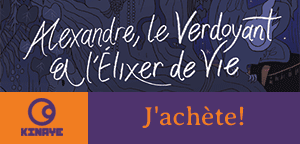Writing
A really straightforward chapter. 6 pages. Just Alexander and the Servant heading out and beginning their quest. You may have noticed the appearance of a couple of ancient Greek words. Originally I had Alexander yelling 'WOOHOO' then replaced it with the vernacular 'EUAI-AI-AI'. Small details, but they mean a lot to me in regards to immersion.
Thumbnailing and Sketching
Tools
Thumbnails: Moleskine notebook, mechanical pencil
Sketches: Procreate, iPad with Apple pencil
Time taken
Thumbnails: 15 minutes.
Sketches: (not counting breaks) Around 3 hours.
Inking and Colouring
Tools
Inks: Huion Kamvas Pro, Photoshop
Colours and Letters: Photoshop
Time taken
Inks: A week and a half of intermittent work. Recovering from minor burnout and juggling that with the remastering of The Carpet Merchant Book 2.
Colours: Around 7 - 8 hours.
Research
The first four pages of the chapter are centered on immersion, or the building and layering of details to construct a lived-in world.Recreating and exploring the historical past through material culture, art history and vernacular folk tradition has always been my niche interest in historical comics. The past feels more alive when I see the things our ancestors used to live their life, express themselves, and find comfort in their favourite foods or trinkets. So I try to evoke that same feeling of wonder and connection in my comics.
In my opinion, material culture is something that is done more effectively in visual storytelling than prose. There is only so much an author can do when presenting the sentence 'Alexander drinks wine from a kylix' to a reader, who may or may not understand what that action looks like... or even what a kylix is. (You can read about my descent into madness when I had to find the answer to this 'How Does One Drink From a Kylix' question) As someone who can present that sentence in the form of an image beamed directly to the reader's mind, I am able to show them how Alexander holds his wide-brimmed cup between his ring and middle fingers (the right hand, because the left is unclean). And that image alone does a lot of work to tell us how interesting their cups are with the individualised designs and how mundane people treated those cups back then. The past then feels lush, with that detail and many others.
In Chapter Two, I wanted to achieve the same goal of immersion in Babylon and its surrounding landscape.
-
I'm a little bored and frankly, annoyed at the standard depictions of ancient Mesopotamia, and in general the Middle East past and present, through the dry yellow-filter lens of Hollywood. Where are the plants? The colours? The green?? Like, I know that part of Iraq (where Babylon city is) has an arid climate and desertification, but there's a concept called land cultivation and apparently, the Mesopotamians of the Ferticle Crescent created this really cool thing called civilisation based off their mastery of agriculture which they also invented. So again, where are the crops and trees that supported and fed the cities? Where is the human touch?
But I'm also annoyed because a big part of why so much of the region looks so dry right now is because of war, sanctions and politics (not to mention the passage of time and climate change, hahahaha). And it's actually the consequences of those factors, and not the land of Babylon as taken care of by its people, that is exported in the form of imagery to the global north. Not to mention the present areas of modern-day Iraq with farmland and gardens... further emphasising the yellow filter as yes, a choice, yes, an artistic license, which displays the decision-maker's laziness of thought and incompetence in making alternative choices. #hottake
-
I wanted a Babylon that was lush and rich, to honour its reputation as a grand, old city in the Fertile Crescent (though at the time of Alexander's reign the place was at its decline... then again, Alexander had been Great King for a while and if I recall correctly, there wasn't any destruction of crops or livelihood to the ordinary folks in Babylon...). If not lush, just enough to show that life was still happening, that food was still being produced. So here's a date palm orchard, a barley field... two of the stable crops of the city. And of course, people who were cultivating and harvesting these crops using their knowledge and labour. The sort of people who are lost to silence while the king and his military hog up the spotlight.




